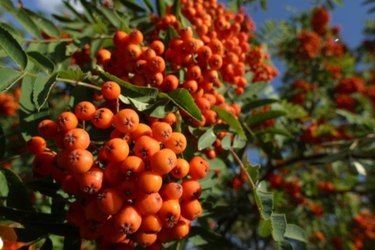
The rowan tree, or European mountain ash, is a relatively small tree of the Rosaceae family. It is an acid-loving tree that thrives in cool, mild climates with full sun and well-drained soils. The rowan produces small, dark green leaves that turn to autumn hues of yellows and purples. It blooms cream-colored flowers that are followed by bright red berry clusters.
Fire Blight
Video of the Day
Fire blight is a destructive bacterial disease that attacks the rowan through its open wounds. This spore-borne bacteria develops on previously infected areas, such as dead branches and defoliation. The spores are transported during the warm rainy periods by wind and rain onto the open wounds. Once in contact with these succulent areas, they cause decay, and the rowan takes on a blighted appearance. The entry points of the infection begin to ooze a bacterial discharge that streak the bark when it dries. The bacterial ooze, often sweetly scented, is carried by insects onto the blossoms, causing the blooms to become water-soaked and wilted. Severely infected areas also develop cankers that house additional bacterial spores. Fire blight cannot be cured with chemical treatments.
Video of the Day
Crown Gall
The rowan is one of the many trees and plants that are susceptible to crown gall. Like fire blight, this bacterial disease enters the rowan through its wounds. However, this soil-borne disease infects the tree through its lower areas, including its roots and trunk. This disease accelerates the infected area's cell development, causing the area to develop galls. Thee galls serve as a shelter for developing bacterial spores, which continue the spread of the disease. Crown gall can live for many years in the soil without a host and has no chemical cure.
Powdery Mildew
Powdery mildew infects the rowan's foliage, stems and fruit. The developing shoots and flowers can also be affected. The spores of powdery mildew develop across the surfaces of the leaves, forming a covering of white fungal mildew. The leaves develop small, necrotic spots underneath the mildew that cause the rowan's foliage to distort, wilt and, at times, fall from the tree. The rowan's blooms may also become distorted or stunted. Powdery mildew infections can be controlled and prevented with pruning and fungicidal treatments.
Prevention
Along with the aforementioned diseases, the rowan tree is also susceptible to rust and leaf-spot diseases, as well as insect infestations that can cause disease-like symptoms. The rowan's best defense against infection is vigorous growth and development. The University of Connecticut explains that stressful growing environments, such as drought, hot temperatures and infestations, can predispose the rowan to disease and reduce its already short lifespan. To reduce the potential for infections, the rowan should be watered and fertilized regularly throughout the growing season, and pruned periodically to remove any disease or distressed areas. The rowan's growing environment should be kept free of defoliation and debris to reduce the presence of fungal and bacterial spores. Though the rowan's fruit is not edible, all the fruit should be removed from the tree just before it enters dormancy, if it is not already removed by birds and other wildlife. When not removed, these mummified fruits can serve as shelter for infectious spores.
- University of Connecticut Cooperative Extension: Sorbus aucuparia
- Missouri Botanical Garden: Sorbus aucuparia
- Colorado State University Extension: Fire Blight; R. D. Koski, et al.; October 2009.
- Clemson Cooperative Extension: Powdery Mildew; Chuck Burgess, et al; November, 2009.
- The University of Arizona Cooperative Extension: Diseases of Urban Plants; Richard Hine, et al.; May, 1999.
- Virginia Cooperative Extension: Crown Gall of Woody Ornamentals; G. H. Lacey, et al.; May, 2009